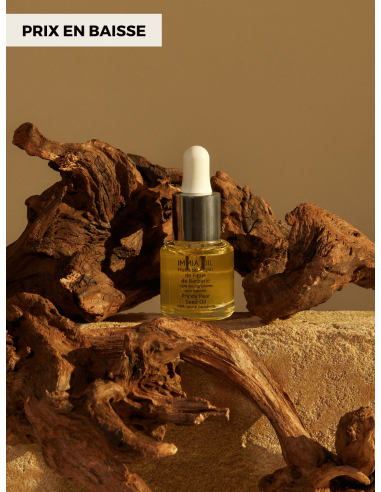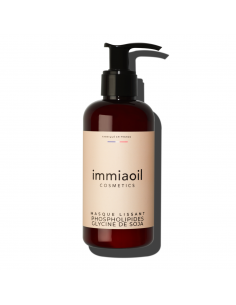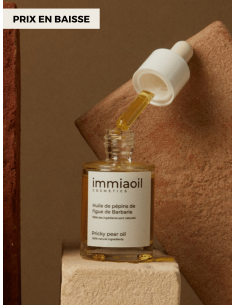Prickly Pear seed Oil 15 ml
Our Prickly Pear Seed Oil is a rare dry oil with strong antioxidant powers that promote cell renewal, reduction of hyperpigmentation and redness. It's an outstanding anti-aging and anti-radical, and is considered a natural medicine to fight against aging. It's suitable for all skin and hair types.
Its benefits:
- Hydrates skin and hair
- Fight against eczema and psoriasis
- Reduces hyperpigmentation, skin spots related to UV exposure
- Stimulates collagen production
- Fights wrinkles and restores firmness and tone to the skin
- Supports the skin's natural repair process
Prickly pear seed oil is a recent discovery in natural cosmetics. It is highly coveted for its benefits to the skin and for its wonderful healing properties.
Obtained by cold pressing, Prickly Pear seed oil is a concentrate of fatty acids, but also of sterols and vitamin E. Similar to Argan oil in its composition, prickly pear seed oil Prickly pear however has higher concentrations of linoleic acid (omega 6) and tocopherol and is extremely valuable since it requires a large amount of prickly pear to produce a small amount of oil.
CONSERVATION :
Store away from light, in a temperate place.
INGREDIENTS :
Opuntia Ficus Indica Seed Oil
WARNING :
The claims, indications, as well as the methods of use are taken from works, sites and/or bibliographical research. All the information provided is given for information only and does not in any way constitute medical information, nor engage our responsibility. For any therapeutic use, consult a physician.
You can use it day or night as a moisturizer, serum and eye cream. Gently dot the eye area to reduce the appearance of fine lines, wrinkles and dark circles.
Apply 1 to 2 pumps morning and/or evening to the face, neck and eye contour while practicing circular movements.
BIBLIOGRAPHY :
· M. Ramadan et J. Mörsel, « Oil cactus pear (Opuntia ficus-indica L.) », 2003, doi: 10.1016/S0308-8146(02)00550-2.
· M. F. Ramadan et J.-T. Mörsel, « Recovered lipids from prickly pear [Opuntia ficus-indica (L.) Mill] peel: a good source of polyunsaturated fatty acids, natural antioxidant vitamins and sterols », Food Chem., vol. 83, no 3, p. 447‑456, nov. 2003, doi: 10.1016/S0308-8146(03)00128-6.
· « Characterization of Opuntia ficus indica seed oil from Tunisia | SpringerLink ». https://link.springer.com/article/10.1007/s10600-009-9448-1 (consulté le juin 28, 2021).
· Z. Ghazi, M. Ramdani, M. L. Fauconnier, B. E. Mahi, et R. Cheikh, « Composition of Seed Oil of Opuntia Ficus Indica and Opuntia Dillenii From Morocco », p. 6, 2013.
· K. Bojanowski, W. R. Swindell, S. Cantor, et R. K. Chaudhuri, « Isosorbide Di-(Linoleate/Oleate) Stimulates Prodifferentiation Gene Expression to Restore the Epidermal Barrier and Improve Skin Hydration », J. Invest. Dermatol., vol. 141, no 6, p. 1416-1427.e12, juin 2021, doi: 10.1016/j.jid.2020.09.029.
· D. M. Pereira, G. Correia-da-Silva, P. Valentão, N. Teixeira, et P. B. Andrade, « Anti-Inflammatory Effect of Unsaturated Fatty Acids and Ergosta-7,22-dien-3-ol from Marthasterias glacialis: Prevention of CHOP-Mediated ER-Stress and NF-κB Activation », PLOS ONE, vol. 9, no 2, p. e88341, févr. 2014, doi: 10.1371/journal.pone.0088341.
· V. N. Nikam, R. C. Monteiro, S. Dandakeri, et R. M. Bhat, « Transepidermal Water Loss in Psoriasis: A Case-control Study », Indian Dermatol. Online J., vol. 10, no 3, p. 267‑271, juin 2019, doi: 10.4103/idoj.IDOJ_180_18.
· H. Masaki, « Role of antioxidants in the skin: Anti-aging effects », J. Dermatol. Sci., vol. 58, no 2, p. 85‑90, mai 2010, doi: 10.1016/j.jdermsci.2010.03.003.
· Y. Kamei, Y. Otsuka, et K. Abe, « Comparison of the inhibitory effects of vitamin E analogues on melanogenesis in mouse B16 melanoma cells », Cytotechnology, vol. 59, no 3, p. 183, juill. 2009, doi: 10.1007/s10616-009-9207-y.
· « MMP1 - un aperçu | Sujets ScienceDirect ». https://www.sciencedirect.com/topics/biochemistry-genetics-and-molecular-biology/mmp1 (consulté le juin 28, 2021).
















